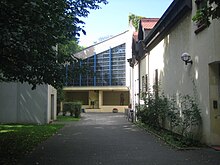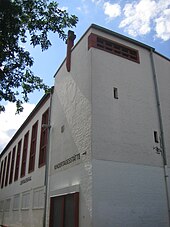Liebfrauen (Mainz)
Liebfrauen is a Roman Catholic church in Mainz . The church is a modern post-conciliar building from the 1960s.
history
The Liebfrauen parish office was established on February 1, 1931 at the north-western end of Mainz Neustadt . This re-establishment had become necessary because the city expansion into the garden field had also increased the need for church buildings. The parishes of St. Josef and St. Bonifaz, which had already been established near the old town, had to be relieved. For more than thirty years, the services took place in the Liebfrauensaal, which was set up as an emergency church and now serves as a community center.
Pre-conciliar
In 1904, Bishop Kirstein , born in Mainz, took over the management of the diocese . Kirstein was valued as a popular pastoral care bishop and was an avowed admirer of Mary . The need for new church space and the need for the destruction of the old Church of Our Lady " St. Maria ad Gradus " to build a new place of worship for the Mother of God prompted Kirstein to ask that a new church be planned for urban planning, because one was in the city map of 1898 third Catholic Neustadtkirche not yet planned. The church should express the in 1854 by Pope Pius IX. the dogmatized "Doctrine of the Immaculate Conception of Mary" and the everlasting virginity of the Blessed Mother Mary.
In 1912 the city made a space available for building the church, but this did not meet the needs of the diocese leadership . The First World War and the subsequent inflation did not allow the prosecution of new church building plans. The project was suspended until 1925, when the city made a new building site available.
The census of 1925 found over 17,000 Catholics for Neustadt. Due to the high population density due to the four to five-story construction in the new district, a further strong increase in the number of potential church visitors was expected. In 1929 an architectural competition was announced based on which 134 designs were received. The Wiesbaden government master builder Eberhard Finsterwalder (1893–1972) won the first prize.
The modern design of the church building could not be realized despite the laying of the foundation stone on December 8, 1929 in the presence of Bishop Ludwig Maria Hugo . Until 1933 only a part of the building project, the community hall, could be built. The large hall on the first floor of the building was used as an emergency church until a new dedicated church building was built . Despite its provisional character, the entrance hall above the portal was decorated in 1933 with a fresco by Albert Burkart depicting the " Annunciation of the Lord ". The sculptor and ceramic researcher Adam Winter (1903–1978) designed the crucifix, stations of the cross and high altar with the Last Supper scene as a ceramic bas- relief . The altar of Mary and the depiction of the Sacred Heart were made as clay sculptures .
As early as 1933, two bells were cast in the workshop of the Carl Friedrich Ulrich / Franz Schilling foundry in Apolda. These are the cross bell with a weight of 225 kg and a Mary bell with a weight of 125 kg. They were housed in the upper part of the hall of the parish hall, the sound openings are elevated above the flat roof of the emergency church.
The pipe organ with 12 registers comes from Carl Tennstädt, Lippstadt.
New construction
During the Second Vatican Council , the architect Bernhard Schmitz from Mainz was commissioned to redesign a church that was to be oriented towards dialogue with the people in their respective situations in order to "renew" and "strengthen the bond of unity" with the church people to demonstrate. On October 1st, 1966, the modern church was consecrated by Bishop Hermann Volk . The creative conception of the Liebfrauen parish church primarily refers to the testimony of God's solemn covenants with people. The two window walls, each divided into three parts, by the artist Peter Paul Etz (1913–1995) show representations from the Old Testament.
The north wall picks up on themes from the Exodus from Egypt from the Book of Exodus , such as the foundation of the Passover meal , the brazen serpent and passage through the Red Sea , the south wall opposite the covenant of God with people on Maundy Thursday with the institute of the Lord's Supper , Christ nailed to the cross and the resurrection of Jesus Christ .
Floor plan and equipment
The spatial conception of the Liebfrauen parish church is oriented towards the east. Even the ground plan in the form of a truncated parabola (Greek parabola = parable) refers to the space's claim to become a parable itself ( parable (language) ): as a holy, sacred space.
The chancel, as the central place of the Eucharistic celebration , is the place of the common celebration of the assembled people of God and thus takes up the basic principle Participatio actuosa of the Catholic liturgical movement of the 20th century. Adam Winter's Stations of the Cross were transferred to the modern church and adorn the concrete back wall of the church. There are 7 stations each on the left and right of the baptismal font. The named Madonna of the emergency church was attached to the outer wall in the south of the building. Inside the sacred space there is a more modern statue of Our Lady. Angels making music have been placed on both sides of the organ.
The associative connection to Alt-Liebfrauen are three casts of Gothic apostles from the tympanum of the church. They represent the evangelist Matthew and James, the son of Zebedee and his brother John . The ceramic bas-relief with the Lord's Supper was on the wall next to the Tabernacle attached. The crucifix from Adam Winter's ensemble is now in the anteroom of the north entrance. Professor Albert Burkart's fresco was whitewashed.
In addition to the parish, the parish church of Liebfrauen also houses the Spanish-speaking Catholic community of Mainz.
literature
- Jürgen Nikolay (Ed.): Mainz Church Leader. Discoveries in Catholic churches in and around Mainz . Leinpfad Verlag, Ingelheim 2004, ISBN 3-937782-18-4 .
Web links
Individual evidence
- ↑ Ludwig Lenhart : Dr. Georg Heinrich Kirstein (1858-1921). The popular pastoral bishop on the Bonifatius chair in Mainz (1903-1921) , in: AmrhKG 17, 1965, p. 121
- ↑ City map (area) of Mainz from 1898
- ↑ The Mainz churches and chapels ; August Schuchert , Verlag Johann Falk III. Sons, Mainz 1931
- ↑ A. Gallei: The St. Mary's Conception Church in the Mainzer Neustadt in Becoming in: Handbuch der Mainzer Diözese , Mainz, 1931, p. 79 f
- ^ Comunidad Católica de Lengua Hispana Mainz
Coordinates: 50 ° 0 '51.16 " N , 8 ° 15' 8.74" E




